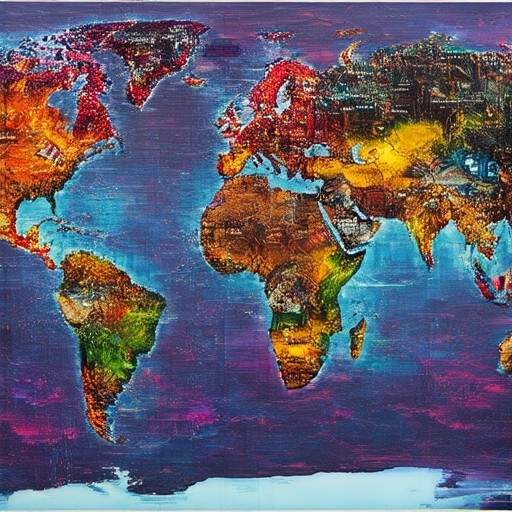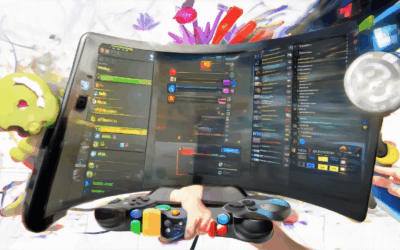Throughout the history of gaming, game art has evolved from simple pixelated characters to breathtakingly detailed worlds that captivate players and tell compelling stories. The art styles used in video games have become a cornerstone of their identity, influencing everything from narrative development to player immersion. Whether it’s the vibrant, hand-drawn animations of classic games or the photorealistic renderings of modern titles, the visual appeal of games is a testament to the creativity and innovation of artists and designers. In this comprehensive guide, we’ll explore the diverse world of game art styles, comparing and contrasting different approaches, analyzing influential works, and providing insights into the techniques that bring these visual masterpieces to life.

Understanding Different Types of Game Art
Game art encompasses a wide variety of styles that cater to different artistic preferences and storytelling needs. Here’s a breakdown of the most common types of game art:
1. Traditional 2D Art
Traditional 2D art is classic and widely used in many genres, including platformers, RPGs, and metroidvania games. This style often features hand-drawn characters and environments with vibrant colors and intricate details.
- Features: Smooth lines, expressive character animations, and detailed world designs.
- Examples: The Legend of Zelda: Breath of the Wild , Super Mario Bros.
- Pros: High emotional impact, versatile for various genres.
- Cons: Requires skilled artists, can appear less dynamic compared to 3D.
2. Photorealistic 3D Art
Photorealistic 3D art combines realistic textures, lighting, and shadows to create lifelike visuals. This style is often seen in open-world games, action games, and simulations.
- Features: Highly detailed textures, dynamic lighting, and immersive environments.
- Examples: Grand Theft Auto V , Horizon Zero Dawn
- Pros: Realistic experiences, advanced rendering techniques.
- Cons: Can be resource-intensive, may lack personality compared to 2D.
3. Stylized 2D Art
Stylized 2D art mixes bold colors, exaggerated features, and unique character designs. This style is popular in indie games, comics, and children’s games due to its accessibility and visual appeal.
- Features: Distinctive character designs, bright color palettes, and whimsical settings.
- Examples: Stardew Valley , Celeste
- Pros: Inexpensive to produce, highly customizable, and visually striking.
- Cons: May feel less polished compared to 3D.
4. Pixel Art
Pixel art involves creating images using individual pixels, often with limited color palettes. This style is nostalgic and has a retro aesthetic, making it ideal for games that aim for a specific visual theme.
- Features: Low-resolution graphics, vibrant color schemes, and chunky designs.
- Examples: Tetris Effect , 8-Bit Hero
- Pros: Affordable to develop, evokes nostalgia, and stands out in competitive gaming.
- Cons: Limited detail, may feel dated to modern audiences.
Comparing 2D vs. 3D Game Art
Choosing between 2D and 3D art depends on the game’s objectives and audience. While 2D art offers flexibility and emotional depth, 3D art provides realism and immersion. Many games combine elements of both styles to create unique visual experiences.
By understanding these art styles and their applications, you can make informed decisions about the visual direction of your game project. Whether you prefer the charm of 2D or the realism of 3D, there’s a style that suits every story and gameplay mechanic.
For more resources and tools to create stunning game art, visit our Indie Dev Games platform. Explore tutorials, reviews, and tips tailored for independent game developers.
Games with Exceptional Art Styles
Cuphead and Streets of Rage 4 are frequently cited as having some of the best art styles in gaming. Cuphead’s hand-drawn, vibrant aesthetic and Streets of Rage 4’s dynamic, modern art style each bring unique charm to the table.
- Cuphead : Known for its retro, hand-drawn animation style inspired by 1930s cartoons, Cuphead offers a visually captivating experience with its colorful and expressive characters.
- Streets of Rage 4 : This game features a fresh take on the beat ’em up genre with its detailed, hand-drawn characters and a vibrant, evolving color palette.
- Ori and the Blind Forest : Features a minimalist yet beautiful art style with watercolor-like textures that immerse players in its world.
- Inside and Limbo : Both games are celebrated for their atmospheric art styles, with Inside’s dark, surreal imagery and Limbo’s monochrome aesthetic standing out.
- Celeste : Known for its clean pixel art and deliberate color choices that enhance its emotional storytelling.
- Don’t Starve : Offers an abstract, hand-painted art style that evolves as you progress through the game.
- Hades : Combines bold, dynamic art with a cohesive design that contributes to its intense, atmospheric experience.
Each of these games excels in visual presentation, making them standouts in the indie game scene. Whether you prefer vibrant, hand-drawn art or atmospheric, minimalist designs, there’s something here for every taste.

Understanding the Four Main Art Styles
The world of art is vast and diverse, encompassing various styles that have shaped the artistic landscape over centuries. Among these, four main art styles stand out as foundational and highly influential. Understanding these styles provides insight into the evolution of art and its cultural significance.
- Impressionism : Born in France during the late 19th century, Impressionism revolutionized art by focusing on the transient nature of light and mood rather than traditional representations. Key figures include Claude Monet and Pierre-Auguste Renoir. Their works capture moments of everyday life with vibrant colors and fluid brushwork.
- Realism : Opposing Impressionism, Realism emphasizes detail, realism, and accuracy. Artists like John Constable and Thomas Gainsborough focused on representing reality with precise technique, often depicting everyday scenes with lifelike precision.
- Abstract Expressionism : Emerging in the mid-20th century, this style prioritizes emotion, color, and form over representational subject matter. Jackson Pollock and Mark Rothko are prominent figures known for their gestural, vibrant works that convey deep emotional states.
- Cubism : Cubism, led by Georges Braque and Pablo Picasso, redefined spatial perception in art. This style breaks down objects into geometric shapes, emphasizing three-dimensionality and perspective to create a unique visual language.
Each of these styles has left an indelible mark on art history, influencing subsequent movements and continuing to inspire contemporary artists. Whether through the fleeting beauty of Impressionism, the meticulous detail of Realism, the emotional intensity of Abstract Expressionism, or the innovative perspectives of Cubism, these styles remain cornerstones of artistic expression.

Types of Video Game Concept Art
Video game concept art encompasses a variety of visual styles and techniques used to bring creative ideas to life in the gaming industry. Here are the primary types of video game concept art:
- Character Design: This type focuses on creating unique and visually appealing characters. It involves designing everything from the protagonist to NPCs, ensuring they are distinct and memorable.
- Environment Art: This category covers the creation of game environments, including landscapes, cities, dungeons, and other playable spaces. It sets the mood and atmosphere of the game.
- Weapon and Armor Design: Concept art for weapons and armor often blends functionality with aesthetics, ensuring they look both realistic and fitting within the game’s style.
- Level Design: This involves creating individual levels or zones within a game, ensuring they are challenging, visually cohesive, and aligned with the game’s theme.
- Concept Sketches: These are quick, rough sketches used to explore ideas before developing detailed artwork. They provide a blueprint for more polished designs.
- Character Concept Art: This includes exploratory designs for characters, experimenting with different looks and personalities to find the perfect fit for the story.
- UI/UX Design: While not always considered concept art, UI and UX design plays a crucial role in shaping the player’s experience through menus, HUDs, and interface elements.
These forms of concept art are essential in the game development process, helping artists communicate their vision and inspire the development team. Platforms like Indie Dev Games offer resources and communities where developers can share and refine their concept art.
The Four Cs of Game Design
The Four Cs of game design are fundamental concepts that every game developer should understand to create engaging and successful games. These principles help define the core elements of a game, ensuring it is enjoyable, challenging, and immersive.
- Content :
- Definition : Content refers to the elements that players interact with, such as levels, characters, objects, and environments.
- Examples : A puzzle game might have mazes, while an adventure game could feature unique weapons and locations.
- Importance : High-quality, relevant, and varied content keeps players engaged and provides a foundation for gameplay mechanics.
- Challenge :
- Definition : Challenge is the difficulty curve that drives player progression. It determines how players grow stronger, learn new skills, or overcome obstacles.
- Examples : In a fighting game, increasing enemy strength or introducing new moves challenges players to adapt their strategies.
- Importance : Proper challenge ensures gameplay remains interesting and rewarding without being overwhelming.
- Character :
- Definition : Characters are the entities players control or interact with, often serving as the primary agents of change in the game world.
- Examples : In an RPG, players might customize their own character or lead a team of heroes.
- Importance : Well-designed characters create emotional connections and provide personalized experiences for players.
- Context :
- Definition : Context encompasses the rules, settings, and narrative that give meaning to the game. It defines how players behave and what actions are meaningful.
- Examples : A sandbox game offers open-ended play, while a competitive game has structured objectives and leaderboards.
- Importance : Clear context helps players understand the goals and expectations of the game, fostering a more enjoyable experience.
By balancing these four elements, game designers can create experiences that are not only fun but also deeply engaging and memorable.

What Genres of Video Art Are There?
Video art encompasses a diverse range of creative expressions, each with unique styles and narratives. Below are the primary genres of video art:
- Narrative Video Art : This genre tells a story through moving images, often with a clear beginning, middle, and end. It can be fictional, documentary, or autobiographical.
- Abstract Video Art : This type focuses on visual experimentation, using shapes, colors, and patterns to convey emotions or concepts rather than a specific narrative.
- Performative Video Art : Often blending live performance with recorded footage, this genre emphasizes the physicality and immediacy of the artist’s presence.
- Experimental Video Art : This genre pushes boundaries, using unconventional techniques, materials, or perspectives to explore new ways of seeing and understanding the world.
- Documentary Video Art : Similar to traditional documentaries, this genre uses non-fictional storytelling to explore real-world issues or people.
- Animated Video Art : Combining animation with artistic themes, this genre creates dynamic and immersive visual experiences.
- Interactive Video Art : This genre engages the audience, allowing them to influence or manipulate the artwork through technology.
Each genre offers a unique perspective, making video art a versatile medium for artistic expression. Whether you prefer narrative-driven works or abstract explorations, there’s something for every viewer to appreciate.
Explore more resources on Indie Dev Games to discover tools and techniques for creating your own video art projects.




0 Comments